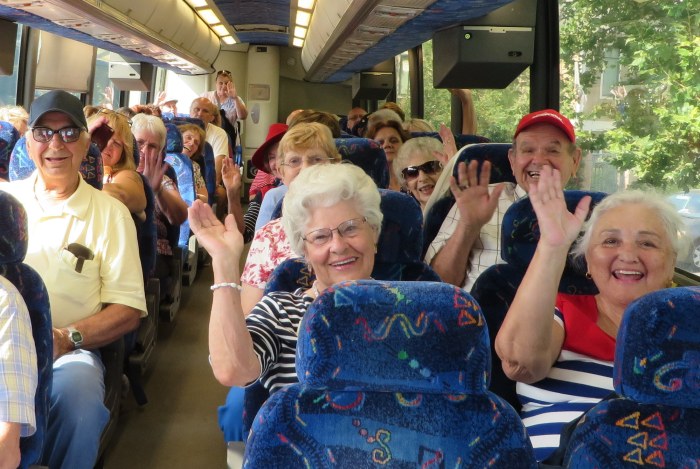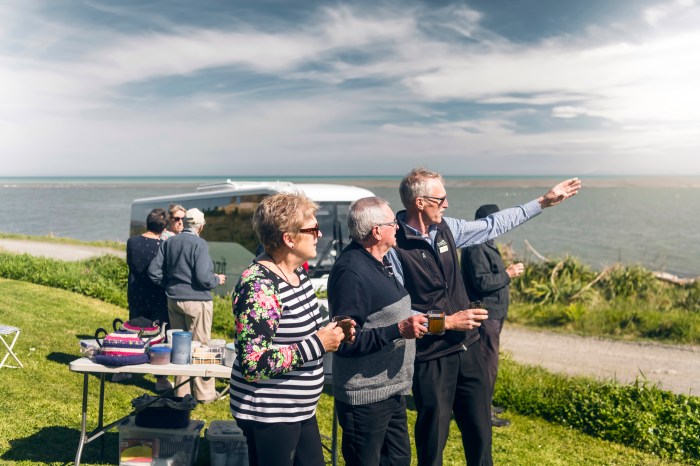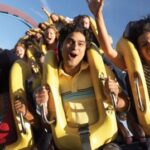Guided Tours For Seniors represent a burgeoning market, catering to a demographic increasingly seeking enriching travel experiences tailored to their specific needs. This isn’t just about sightseeing; it’s about crafting journeys that prioritize comfort, accessibility, and engagement, fostering social connection and enriching the lives of older adults. We’ll explore the nuances of designing, marketing, and executing successful tours, examining everything from itinerary planning to ensuring inclusivity and safety for diverse senior populations.
From carefully curated historical walking tours with frequent rest stops to scenic nature excursions adapted for various mobility levels and culturally immersive experiences incorporating assistive technologies, the possibilities are vast. The key lies in understanding the unique physical, cognitive, and social needs of this demographic and designing tours that not only meet but exceed their expectations, creating memorable and fulfilling adventures.
Accessibility and Inclusivity

Designing guided tours specifically for senior citizens necessitates a meticulous approach to accessibility and inclusivity. Failing to account for the diverse needs and abilities of this demographic can significantly diminish the overall experience, potentially excluding individuals who would otherwise benefit from the tour. A successful program prioritizes creating an environment where all participants, regardless of physical or cognitive limitations, feel welcome, engaged, and comfortable.
Key Accessibility Features for Diverse Senior Needs
Several key design elements must be incorporated to ensure accessibility for seniors with varying needs. These features directly impact the overall enjoyment and understanding of the tour. Careful consideration of these features will translate to a more enriching and inclusive experience for all participants.
- Visual Accessibility: Large-print materials, high-contrast color schemes, and clear, uncluttered signage are crucial for individuals with low vision. Audio descriptions accompanying visual displays can further enhance comprehension. Sufficient lighting in all areas, minimizing glare and shadows, is also vital.
- Auditory Accessibility: Tours should incorporate clear and amplified audio, with options for assistive listening devices like personal FM systems for those with hearing impairments. Providing written transcripts of audio presentations or using captioned videos can further assist those with hearing difficulties.
- Cognitive Accessibility: Tours should be structured with manageable chunks of information, incorporating regular breaks and opportunities for interaction to prevent cognitive overload. Simple language, clear instructions, and visual aids can support comprehension for individuals with cognitive impairments. Providing pre-tour materials summarizing key information can also be beneficial.
- Physical Accessibility: The tour route should be wheelchair accessible, with ramps, elevators, and wide pathways. Rest areas with seating should be strategically placed along the route to allow for breaks. Consider the availability of accessible restrooms and transportation.
Strategies for Inclusive Communication and Engagement
Effective communication is paramount to ensuring an inclusive experience. Addressing potential communication barriers proactively can significantly improve participation and enjoyment for all seniors.
- Pace and Structure: Maintaining a moderate pace and providing structured breaks allows for adequate processing time. Overly fast-paced tours can be overwhelming for many seniors.
- Communication Styles: Employing clear, concise language and avoiding jargon is crucial. Using multiple communication methods (visual aids, demonstrations, storytelling) caters to diverse learning styles and abilities.
- Interactive Elements: Incorporating interactive elements, such as group discussions, hands-on activities (where appropriate), and opportunities for questions, enhances engagement and encourages participation from all.
- Staff Training: Training tour guides on effective communication strategies, including patience, empathy, and sensitivity to diverse needs, is essential for creating a welcoming and inclusive environment. Guides should be equipped to handle potential communication challenges and adapt their approach as needed.
Adaptive Technologies and Tools
Utilizing adaptive technologies can significantly enhance the tour experience for seniors with disabilities. These tools offer opportunities for personalized engagement and improved accessibility.
- Assistive Listening Devices: FM systems and personal listening devices allow individuals with hearing impairments to hear the tour guide clearly.
- Magnification Devices: Handheld magnifiers or digital magnification apps on tablets can assist individuals with low vision in reading materials and viewing exhibits.
- Augmentative and Alternative Communication (AAC) Devices: These devices can aid individuals with communication difficulties in expressing their needs and participating in discussions.
- Accessible Mobile Apps: Apps providing audio descriptions, translations, and interactive maps can significantly enhance the tour experience for a wide range of abilities.
Safety and Support: Guided Tours For Seniors
Prioritizing the safety and well-being of senior participants is paramount for successful and enjoyable guided tours. A comprehensive approach encompassing preventative measures, emergency protocols, and readily available support systems is crucial for mitigating risks and ensuring a positive experience for all. This section details the safety protocols, the role of the tour guide, and a checklist for tour operators to guarantee a secure and supportive environment.
Robust safety protocols are essential for senior tour groups, given the potential for increased vulnerability among older adults. These protocols should address a range of potential hazards, from falls and medical emergencies to transportation accidents and environmental factors. Effective communication and proactive planning are key to minimizing these risks.
Emergency Procedures
Emergency procedures must be clearly defined and readily accessible to all tour participants and staff. This includes establishing clear communication channels, identifying designated meeting points, and outlining steps to take in various emergency scenarios, such as medical emergencies, severe weather events, or security incidents. Detailed contact information for emergency services and designated personnel should be readily available. Regular drills and training sessions can further enhance preparedness and response capabilities.
For example, a simulated medical emergency drill can familiarize staff with efficient evacuation and first aid procedures. Pre-trip briefings for participants should explicitly cover these procedures, ensuring understanding and confidence.
Tour Guide Responsibilities
Tour guides play a critical role in ensuring the safety and well-being of senior participants. Their responsibilities extend beyond providing historical information or cultural insights. They serve as primary points of contact, offering assistance with mobility, managing medical needs, and providing emotional support. Guides should be trained in basic first aid and CPR, possess strong communication skills, and be adept at identifying and addressing potential safety concerns proactively.
For example, a guide might adjust the tour pace to accommodate slower walkers or ensure participants remain hydrated in hot weather. A skilled guide will anticipate potential issues and adjust accordingly, creating a safe and comfortable environment.
Safety Checklist for Tour Operators
A comprehensive checklist helps tour operators systematically address all safety aspects. This checklist serves as a guide and should be adapted to specific tour circumstances.
| Checklist Item | Yes/No |
|---|---|
| Emergency contact information readily available for all participants and staff | |
| Designated meeting points established for various scenarios | |
| First aid kit adequately stocked and readily accessible | |
| Tour itinerary designed to accommodate the physical limitations of senior participants | |
| Transportation arrangements that prioritize safety and comfort | |
| Pre-trip briefing covering safety procedures and emergency protocols | |
| Staff trained in basic first aid and CPR | |
| Risk assessment conducted for each tour location | |
| Contingency plans developed for unforeseen circumstances | |
| Regular communication with participants throughout the tour |
Marketing and Promotion

Attracting senior travelers requires a nuanced marketing strategy that speaks directly to their needs and preferences. Unlike younger demographics, this market segment values security, comfort, and tailored experiences. Effective marketing campaigns must emphasize these elements while leveraging channels preferred by older adults.Marketing materials must clearly articulate the unique value proposition of the tours. This goes beyond simply listing features; it’s about showcasing the benefits.
For example, instead of stating “comfortable transportation,” highlight “stress-free travel with spacious, climate-controlled vehicles and experienced drivers.”
Marketing Materials
Brochures and website copy should utilize large, easy-to-read fonts and visually appealing imagery depicting happy, active seniors enjoying the tour experiences. High-quality photographs of destinations and accommodations, alongside testimonials from previous participants, build trust and credibility. Detailed itineraries, clearly outlining daily activities and accessibility features, address a key concern for senior travelers: knowing what to expect. The use of concise, straightforward language avoids overwhelming potential customers.
Brochures should include contact information, booking details, and a clear call to action, such as a phone number or website link. Website copy should be optimized for search engines, using s relevant to senior travel, such as “accessible tours,” “senior travel groups,” and “retirement community excursions.”
Reaching the Target Audience
Direct mail campaigns targeting retirement communities and senior centers can be highly effective. These locations offer concentrated access to the desired demographic, allowing for personalized outreach. Print advertisements in publications frequented by seniors, such as AARP publications or local senior center newsletters, also offer targeted exposure. Furthermore, digital marketing strategies should not be overlooked. While seniors may be less active on social media than younger generations, many utilize email and search engines.
Targeted online advertising campaigns on platforms like Google Ads, focusing on s relevant to senior travel and specific geographic locations, can generate significant leads. Collaborations with travel agencies specializing in senior tourism can also expand reach and build credibility. Participating in senior-focused events and trade shows provides direct interaction with potential customers.
Marketing Approach Comparison, Guided Tours For Seniors
While direct mail campaigns offer a high degree of targeting, they can be expensive. Digital marketing, while potentially less costly, requires expertise in and online advertising. A multi-channel approach, combining both traditional and digital methods, often yields the best results. For instance, a direct mail piece could include a QR code linking to a dedicated landing page on the tour operator’s website, offering further details and online booking capabilities.
This integrated approach maximizes exposure and provides flexibility for the customer’s preferred method of engagement. The effectiveness of each approach should be rigorously tracked and analyzed to inform future marketing strategies. Key performance indicators (KPIs) such as website traffic, conversion rates, and booking numbers should be monitored to optimize campaign performance. A/B testing different marketing materials and channels helps to refine messaging and targeting for optimal results.
Ultimately, the success of Guided Tours For Seniors hinges on a holistic approach. It’s about more than just ticking off sightseeing locations; it’s about creating a safe, engaging, and enriching experience that caters to the diverse needs of senior travelers. By prioritizing accessibility, inclusivity, and thoughtful planning, tour operators can unlock a significant market and contribute to the well-being and happiness of a growing segment of the population.
The future of senior travel is vibrant, and the potential for growth is immense.

